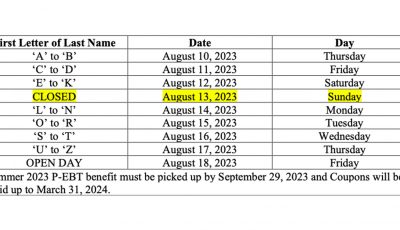MOA in the works to address ‘gaps’ in social services
The Eloy S. Inos administration and social service agencies are finalizing a memorandum of agreement to, among other strategies, systemically move unemployed locals who get food stamps into the workforce.
CNMI Department of Labor and Food and Nutrition executives met with Inos officials as part of a follow-up to the administration’s inaugural special commission on “economic opportunity” earlier this month.
The officials aim to get people to actively look for jobs and not “game” the system, Saipan Tribune learned. They have identified three “gaps” between local Labor programs and Nutrition Assistance Program programs that must be addressed in order to motivate food stamp beneficiaries to actively look for jobs. These “gaps” refers to ones in relationship between the two services.
There are about 500 food stamp beneficiaries who are registered under a work registration program under the Labor Department.
A statement from acting governor Ralph DLG Torres’ office describes these “gaps” as:
• The limited training available to NAP recipients who are looking for a job;
• The lack of adequate disincentives in the current NAP program that keeps applicants from pursuing a job; and
• The lack of a method to streamline data of social service applicants into one portal, for access for policy and program officials looking to track or monitor the success of these benefits.
The first gap
According to the statement, officials have targeted mandatory workforce training programs that are currently being developed, such as a Prepping for Success course at the Northern Marianas Technical Institute. The programs will “cover a variety of workforce readiness courses that build the necessary skills to enter and succeed in the job market.”
This training, the statement said, is planned as a “compulsory component of the NAP registration process.” It will be funded using available workforce training funds through the Department of Labor’s Workforce Investment Agency.
Officials have discussed an amount of about $50 to train an applicant, meaning about $25,000 will be needed to train these NAP applicants, officials said.
Second gap
On the second gap, officials look to a system that NAP has already developed through a memorandum of understanding with the U.S. Food and Nutrition Services.
This program would target those who are required to seek employment but “are not committed to the work registration process.”
NAP has outlined their approach to disqualify certain NAP recipients if they do not follow through with the terms of the work registration process.
If an individual is required to seek out employment and does not, for instance, go to a scheduled job interview—or attempts to circumvent the system—that individual will be disqualified from receiving benefits for three months for the first violation, six months for the second, and a permanent disqualification for the third.
“This is not meant to be overly punitive,” the administration said. It’s to let people know that they must take the job-hunting part seriously.
According to Inos officials, Labor intends to provide data on participants to NAP following their registration into the WIA workforce placement program.
Third gap
To address the third gap, officials focused on an online portal that Labor has created to register applicants for the WIA program.
Officials are working on how this portal can be expanded to encompass the other social service programs, such as NAP, to create a comprehensive database of services being provided throughout the CNMI.
They call it a “virtual one-stop center.”
Among other benefits, the administration believes the new portal would allow specific programs to tailor services, in collaboration with other service providers, “to create an individualized roadmap out of poverty.”
The agreements made during this discussion will be outlined in a memorandum of agreement between the Department of Labor and NAP. The MOA is currently being drafted to reflect the discussions of the meeting.



























